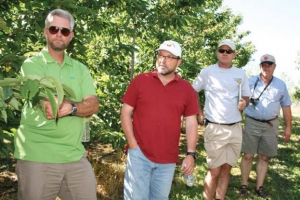
David Geen (in red) discusses his pruning philosophy to an international group that visited his orchard. Pictured with him are (from left) Hank Markgraf, field services manager with the Okanogan Tree Fruit Cooperative, Antonio Walker from Chile, and Hans Meiring from South Africa.
The vast majority of the cherries that he grows at Coral Beach Farms, Ltd., at Winfield, are varieties bred in Summerland, British Columbia. They include Sweetheart, Lapins, Staccato, Sovereign, Satin, and Sentennial. Most are self-fertile and tend to set large crops.
In 2009, like many other Pacific Northwest cherry growers, Geen had a bumper crop and had to resort to hand thinning the fruit. But, he said, he prefers to regulate the crop through pruning. With the Summerland varieties, he prunes on the assumption that there will be a heavy set.
He begins pruning in November to devitalize the established trees, then prunes the younger blocks later in the dormant season. He has a small, experienced pruning crew.
“Pruning is the whole foundation,” he said. “If you don’t have the tree well pruned, the rest of it’s not going to work. They will be overcropped or undercropped.”
Geen has open-vase-style trees in a leased block, but prefers the central leader, which he says is easier to manage and generates earlier production. “With the central leader, you can go in in August and prune out the top. With the open vase, you have vigor popping up all over the place,” he explained.
With the central leader, he likes to plant on a spacing of 15 feet between rows and six or seven feet between trees, with the idea that eventually he will remove alternate trees. He flattens the young branches with toothpicks and does minimal pruning until the trees are in production. He expects a crop of about three tons per acre in the third leaf.
As the trees grow, he prunes out the strong branches. Most of his trees are on Mazzard rootstocks and throw out a lot of growth, he said, and that forces him to prune aggressively. Typically, he prunes out a third of the canopy every year, which creates a continuous supply of new wood in the tree. Pruners use chain saws on poles to remove heavy wood from the tops of the trees and maintain the height at about 12 feet so workers can pick the cherries from nine-foot ladders.
In 2005, he planted a Sweetheart block with only four feet between trees and found that inter-root competition had a dwarfing effect on the trees. “You get some dwarfing effect just by containing them in a tight planting,” he said.
However, over time it gets harder and harder to get new wood in the bottom of the tree, so Geen is thinking of rotating alternate trees in that block, rather than removing them. He cut alternate trees back to the trunk and is regrowing them. He scored the leader to stimulate branching. When those trees have regrown, he might cut back the other trees and regrow them.
“What I don’t know is, will you have enough sun on the tree to get good branch development,” he said. “I want to play with that idea for a couple of years before I jump in commercially. I’m not convinced it will work yet, but it’s always good to have some new idea you’re playing with.”
Varieties
Geen grows Rainier cherries as well as the Summerland varieties. “And I have 21 Bing trees to remind myself why I don’t grow them,” he said. His orchard extends from lake level to 1,500 feet in elevation. Harvest runs from July 10 to late August at his main location. He has a high-elevation orchard 20 miles to the north where he hopes that the Sentennials will ripen in early September, giving him a seven-week marketing window.
Geen said he had a reasonable year in 2009, compared to most growers, because he probably has the latest-maturing commercial cherries in the Northern Hemisphere and has a lot of fruit in August. He won’t plant more Lapins because of its narrow harvest window. He does well with Sweetheart because of the moderate lakeside microclimate, and there’s a good market for it. In hot conditions, Sweetheart will grow in May and June, and then stall.
“I have concerns about the Summerland varieties in the hot districts because I think there’s the potential for poor quality. You can’t grow them in the same place as Bing. Cherries are very specific to microclimates where they will do well.”
There are a lot of trees of Summerland varieties in other growing regions that are just reaching full production, he said, and he fears that growers might not fully understand how precocious they are and what the cropping potential is.
“They have the genetic ability to produce large crops,” he said.
Geen has increased his cherry plantings over the years. At one time, he had 70 acres of apples, but he only has 25 acres now. He packs his own cherries in what he describes as a “relatively low-tech” packing house. Employees work in teams of three or four to grade the fruit. “It’s high input because I’m aiming for a very clean pack,” he said. “I think the more mechanized your line, the more you’re going to struggle to maintain the quality.”

Leave A Comment